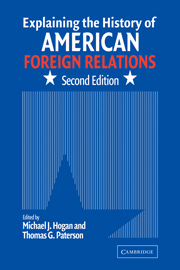Book contents
- Frontmatter
- Contents
- Preface to the Second Edition
- Contributors
- 1 Introduction
- 2 Defining and Doing the History of United States Foreign Relations : A Primer
- 3 Toward a Pluralist Vision : The Study of American Foreign Relations as International History and National History
- 4 Theories of International Relations
- 5 Bureaucratic Politics
- 6 Psychology
- 7 National Security
- 8 Corporatism
- 9 World Systems
- 10 Dependency
- 11 Considering Borders
- 12 The Global Frontier : Comparative History and the Frontier-Borderlands Approach
- 13 Modernization Theory
- 14 Ideology
- 15 Culture and International History
- 16 Cultural Transfer
- 17 Reading for Meaning : Theory, Language, and Metaphor
- 18 What's Gender Got to Do with It? Gender History as Foreign Relations History
- 19 Race to Insight: The United States and the World, White Supremacy and Foreign Affairs
- 20 Memory and Understanding U.S. Foreign Relations
- Index
18 - What's Gender Got to Do with It? Gender History as Foreign Relations History
Published online by Cambridge University Press: 05 June 2012
- Frontmatter
- Contents
- Preface to the Second Edition
- Contributors
- 1 Introduction
- 2 Defining and Doing the History of United States Foreign Relations : A Primer
- 3 Toward a Pluralist Vision : The Study of American Foreign Relations as International History and National History
- 4 Theories of International Relations
- 5 Bureaucratic Politics
- 6 Psychology
- 7 National Security
- 8 Corporatism
- 9 World Systems
- 10 Dependency
- 11 Considering Borders
- 12 The Global Frontier : Comparative History and the Frontier-Borderlands Approach
- 13 Modernization Theory
- 14 Ideology
- 15 Culture and International History
- 16 Cultural Transfer
- 17 Reading for Meaning : Theory, Language, and Metaphor
- 18 What's Gender Got to Do with It? Gender History as Foreign Relations History
- 19 Race to Insight: The United States and the World, White Supremacy and Foreign Affairs
- 20 Memory and Understanding U.S. Foreign Relations
- Index
Summary
The request to write this essay came the day I submitted my tenure papers. These had forced me to articulate why I considered myself both a women's historian and a historian of U.S. foreign relations. As I struggled to explain my research interests in the allotted three pages, I imagined the assorted deans, chemists, and engineers who would eventually read my file shaking their heads and asking: “What's gender got to do with it?” This was a question I had confronted quite often in the early nineties, when I was a graduate student in women's history embarking on a dissertation on the Spanish-Cuban-American and Philippine-American Wars. But the ascent of cultural and social history meant that in the past decade I have heard this question less and less from my colleagues.
Roughly half the faculty in my department characterize themselves as cultural historians – a term that obscures as much as it illuminates, for their interests could also be categorized as social, economic, political, and other subsets of history. In the academic circles I frequent, my disparate interests rarely raise eyebrows. After all, it's been over fifteen years since Joan Scott published her influential article “Gender: A Useful Category of Historical Analysis” that made the case for using gender to understand issues of power. Drawing on contemporary feminist scholarship, Scott maintained that gender did not refer to fixed biological differences between men and women but to socially-determined symbols, norms, and identities.
- Type
- Chapter
- Information
- Explaining the History of American Foreign Relations , pp. 304 - 322Publisher: Cambridge University PressPrint publication year: 2004
- 2
- Cited by



